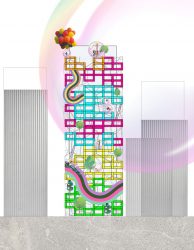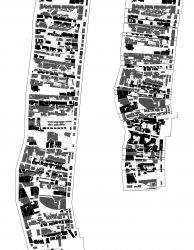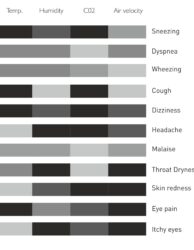
From the Later: A Call for “a posterior” Design Process
by Thomas Mouton
In 1991 Francis Fukuyama published The End of History and the Last Man signally the triumph victory of western Neoliberal democracy with the fall of the Soviet Union. The publication of this book signaled a collective embrace of liberal democracy and its underlying economic system through the dissemination and embrace of the “End of History”. The end of history did not invent this system so much as it established the parameters that now define the prevailing social and economic ideologies. The phrase “the end of history” itself serves to establish this system as a symbolic transcendental horizon similar to the epistemological limits laid out in Kant’s transcendental idealism. 2020 has served as a catalyst of sorts bringing focus to inequality and the systemic flaws prevalent through almost every facet of our lives and built environment and testing the limits of Fukuyama’s declaration through critiques of existing systems. However familiar Architecture and design are with these issues ,the fact is that they still remain prominent and thoroughly resilient to previous attempts at redress. Each solution while well thought out has fallen victim to this transcendental horizon, due to the fact that these solutions are framed within a system responsible and therefore mimic it. In spite of these circumstances, an opportunity has presented itself as the parallax effect has been weakened through the sheer number of issues and crisis brought to light. With all this attention and focus can we still embrace Octave Mannoni’s phrase ”I know very well, but all the same”1?
A little over a decade removed from the 2008 financial crisis we find ourselves revisiting similar issues of inequality and transfers of wealth and exclusion. In the aftermath most academic research focused on what lead to the crisis through a close examination of technical factors at play by closely examining specific variables. In Raghuram Rajan’s 2010 book Fault Lines he proposed that a rise in political pressure to provide mortgages to unqualified low income earner helped fuel the 2008 financial crisis2. Of course this thesis was later challenged by Micheal Bordo’s research that further examined economic indicators and proposed that income inequality was not in fact directly correlated to financial boom and bust3. Each of these positions is consistent in its failure to incorporate the more nuanced aspects of the crisis as they continue to need redress in 2020.
Understandably the nature of research like this is to remain well within strict parameters in order to examine intricate financial data. This narrowly focused exercise strives for clarity through subtraction as a limited amount of variables are examined. In doing so, this subtractive process provides a consistent context and control by explaining the inability to step beyond. What this leads to is an all too common misinterpretation of the fundamental characteristics of a system as temporal flaws.
The ability to step beyond restrictive boundaries are welcome within the design field as any designer should be initially more interested in what question is being posed placing focus on the discovery of the root issue at hand. A current focus on new technology and potential advances in materials has shifted focus towards solutions first approach, providing less time to investigate causation versus correlation. One issue where this approach is for too prevalent is with attempts to address affordable housing as merely an issue of overinflated housing cost. This misguided approach is understandable if one only looks at US census data. For example, looking at housing prices from the 1970’s you get an average home price of $17,0004 with inflation and the increase in the average square footage of a home you arrive at $153,000 dollars5. In 2020, the average home price in the US was around $360,000 which comes out to a 150% increase in home prices. This data on its own presents the issue clearly as one solved through cost reduction and explains the constant push to solve it through technology and automation. These current trends are undermined when this housing price inflation is coupled with a study put out by the Economic Policy Institute that concludes with a recommended increase in the minimum wage from 7.25 to 18.43/hr in order to account for inflation and increase US worker production6. Not so coincidentally, this recommended increase in the minimum wage works out to an approximate 150% increase. So with this new information, the initial trends and proposals aimed at solving the housing crisis appeared flawed as they address symptoms.
The two sets of data regarding housing price inflation and wage stagnation on their own are examples of “a priori” knowledge or justification without experience. In contrast, if these two separate points of data were combined with introspection and experience they would possibly become “a posteriori”. The current fixation on price suppression through things like automation appear vastly different when looking at the issue through the lens of the very workers possibly being displaced and the wages subsequently stagnated or suppressed. These very workers and trades people are the ones most affected by both the initial issue and the possible solution.
It is the subtle difference between “a priori” and “a posteriori” knowledge that has found us repeatedly addressing symptoms as we continue to misidentify causation. In the affordable housing example given we can see solutions that offer temporary relief while doing little to redress the fundamental causation or underlying issues. Since we are all Fukuyamist in our embrace of the predominant system at play we need to propose outcomes not already produced by the very system we are trying to fix. This process is becoming emblematic of the design field’s response and attempts to address issues as if inspiration was drawn from Mannoni’s writing “I know very well, but all the same”. The recent focus on deeper systemic issues of oppression and exclusion only increase the call for adjustment in this approach. Our ability to metaphorically step beyond the transcendental horizon is reliant on our ability to utilize “a posteriori” knowledge in design.
[1] Mannoni, O. (2003). “I know well, but all the same…”. Perversion and the Social Relation, 68-92. doi:10.1215/9780822384724-004
[2] Rajan, R. G. (2012). Fault lines – how hidden fractures still threaten the world economy. Harpercollins India.
[3] Bordo, M., & Meissner, C. (2012). Does inequality lead to a financial crisis? doi:10.3386/w17896
[4] US Census Bureau Historical Census of Housing Tables Home Values. “US Census Bureau Historical Census of Housing Tables Home Values.” Historical Census of Housing Tables Home Values – Housing Topics – U.S. Census Bureau, June 1, 2000. https://www.census.gov/hhes/www/housing/census/historic/values.html.
[5] “Consumer Price Index, 1913-.” Consumer Price Index, 1913- | Federal Reserve Bank of Minneapolis. Accessed December 15, 2019. https://www.minneapolisfed.org/about-us/monetary-policy/inflation-calculator/consumer-price-index-1913-
[6] Mishel, Lawrence. “Wage Stagnation in Nine Charts.” Economic Policy Institute. Accessed December 15, 2019. https://www.epi.org/publication/charting-wage-stagnation/ Chart 8.




